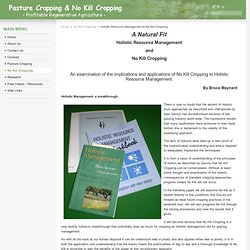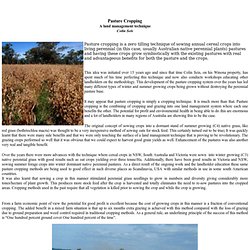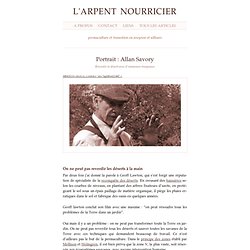Zoom
Trash

Index. Regenerating the Grasslands of Patagonia. Savory Institute Video for USDA. Holistic Resource Management & No Kill Cropping. A Natural Fit Holistic Resource Management and No Kill Cropping An examination of the implications and applications of No Kill Cropping to Holistic Resource Management.

By Bruce Maynard Holistic Management- a breakthrough. There is now no doubt that the advent of Holistic style approaches as described and championed by Alan Savory has revolutionised sections of the grazing industry world wide. The lack of industry-wide take-up is also proof of the sophisticated understanding and ethics required to adequately implement the techniques. It is from a basis of understanding of the principles of holism as described by Savory that No Kill Cropping can be contemplated. In the following pages we will examine No Kill as it relates directly to the conditions that Savory put forward as ideal future cropping practices in his landmark text.
As with all the tools at our human disposal it can be understood well or poorly and also applied either well or poorly. “Keep Soil Covered Throughout The Year” Google Traduction. Pasture Cropping. Pasture Cropping A land management technique Pasture cropping is a zero tilling technique of sowing annual cereal crops into living perennial (in this case, usually Australian native perennial plants) pastures and having these crops grow symbiotically with the existing pastures with real and advantageous benefits for both the pasture and the crops.

This idea was initiated over 15 years ago and since that time Colin Seis, on his Winona property, has spent much of his time perfecting this technique and now also conducts workshops educating other landholders on the methodology. This development of the pasture cropping system over the years has led many different types of winter and summer growing crops being grown without destroying the perennial pasture base. It may appear that pasture cropping is simply a cropping technique. From a farm economic point of view the potential for good profit is excellent because the cost of growing crops in this manner is a fraction of conventional cropping. Google Traduction. Portrait : Allan Savory. MINOLTA DIGITAL CAMERA" rel="lightbox[1148]" > On ne peut pas reverdir les déserts à la main Par deux fois j’ai donné la parole à Geoff Lawton, qui s’est forgé une réputation de spécialiste de la reconquête des déserts.

En creusant des baissières selon les courbes de niveaux, en plantant des arbres fixateurs d’azote, en protégeant le sol sous un épais paillage de matière organique, il piège les pluies erratiques dans le sol et fabrique des oasis en quelques années. Geoff lawton conclut son film avec une maxime : “on peut résoudre tous les problèmes de la Terre dans un jardin”. Oui mais il y a un problème : on ne peut pas transformer toute la Terre en jardin. Cela pose un problème pour les écosystèmes de prairie : quand on les laisse en jachère en les protégeant contre le pâturage et l’exploitation agricole, les grandes prairies de la Terre ne se reconstituent pas.
Désertification et réchauffement climatique. Allan Savory: How to green the world's deserts and reverse climate change. Holistic Management at Work. Allan Savory - Keeping Cattle: cause or cure for climate crisis? SAVORY INSTITUTE HOLISTIC PLANNED MANAGEMENT. Allan Savory: How wildlife can resuscitate dying land. Savory Institute. Savory Institute (SavoryInstitute) sur Twitter.